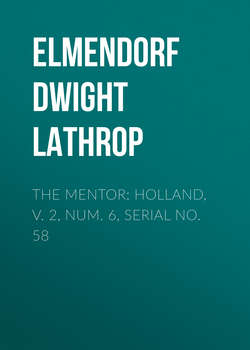Читать книгу The Mentor: Holland, v. 2, Num. 6, Serial No. 58 - Elmendorf Dwight Lathrop - Страница 3
Amsterdam
ОглавлениеTHREE
Amsterdam has often been called “The Venice of the North.” Between the two cities there is a resemblance; but they also differ from each other essentially. Venice is golden; while Amsterdam is gray. Venice inspires romantic memories and poetical associations; Amsterdam, even with its many attractions, is distinctly practical and commercial.
Amsterdam is a seaport in the province of North Holland. It is one of the chief commercial cities in Europe and the largest city in the kingdom of Holland. It is one of the wealthiest cities in the world.
Amsterdam stands on flat, marshy ground into which piles fifty feet long are driven to form the foundations of brick houses, which are usually six or seven stories high. The form of the city is a crescent, and the arms of its canals project into the Y.
Amsterdam is really a city founded upon islands, ninety in all. It has miles of liquid streets, which are spanned by three hundred bridges. All through the city float heavy barges, many of which are the homes of citizens.
Among some classes of the Dutch it is customary, when a young man has saved or borrowed enough money, to buy a huge, broad-shouldered boat and install therein not only his entire family, but also his poultry, hogs, and even cows. From then on he is independent, and master of his own floating house, stable, farmyard, and express wagon. He transports loads of merchandise from town to town, and is in a small way even a farmer. When he moors his boat to take his wares from house to house he uses a cart, and to draw this cart he employs dogs. When the merchandise is sold the driver calmly seats himself in the cart and makes his patient animals pull him home. If he does not own a dog, he merely puts the yoke upon the shoulders of his wife, and she acts as a willing steed.
The little houses in the vicinity of Amsterdam are thoroughly characteristic of Holland. They have sharply pointed roofs of pretty red tiles, neatly painted walls and blinds, and a monstrous windmill on one side. Within they are scoured and polished so that they almost shine with cleanliness. Even among the wealthy citizens of Amsterdam there is not much display of luxury. The houses are quite plain, but always brightly clean.
To most people who are used to paved streets and plenty of dry land it would not be pleasant to dwell among the watery streets with their narrow sidewalks of Amsterdam; but to a Dutchman it is impossible to have too much water about his house. Even with a canal in front and another on each side he will add, if possible, an artificial pond in his small garden.
